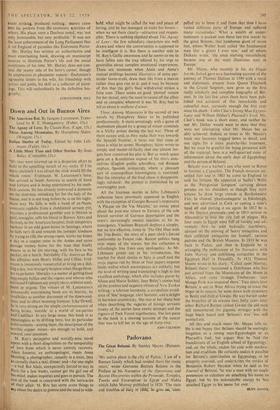Padovano
'My native place is the city of Padua : I am of a Roman family which had resided there for many years,' wrote Giovanni Battisla Belzoni in the Preface to his Narrative of the Operations and Recent Discoveries within the Pyramids. Temples, Tombs and Excavations in Egypt and Nubia which John Murray published in 1820. The state and troubles of Italy in 1800,' he goes on; 'corn,
pelted me to leave it and from that time I have visited different parts of Europe and suffered many vicissitudes.' What a wealth of under- statement is packed into those last few words by the great Belzoni. that handsome giant of seven feet, whom Walter Scott called 'the handsomest man (for a giant) I ever saw,' and of whom Dickens wrote. 'the once starving mountebank became one of the most illustrious men in Europe.'
Mr. Mayes, who recently in his An Organ' for the Sultat gave us a fascinating account of the
journey of Thomas Dallam in 1599 with a royal and diplomatic present from Queen Elizabeth to the Grand Seignior, now gives us the first really scholarly and complete biography of Bel- zoni. In the last few years there have been pub- lished two accounts of this remarkable and colourful man, curiously enough the first ever
since his, death: Colin Clair's Strong Man Egypto- logist and Willson Disher's Pharaoh's Fool. Mr.
Clair's book was a short essay, and neither he nor Mr. Disher would want to deny that they were not attempting what Mr. Mayes has so
ably achieved. Indeed, at times in Mr. Mayes's book one becomes bogged down in detail, and one sighs for a more pastiche-like treatment. But we must be grateful for being presented with all the material; -here is a well-quarried mine of information about the early days of Egyptology and the person of Belzoni.
Belzoni was a barber's son who, went to Rome to become a Capuchin. The French invasion un- settled him and in 1803 he came to England to seek his fortune. He appeared at Sadler's Wells as the 'Patagonian Sampson' carrying eleven persons on his shoulders as though they were kittens; he drew large crowds at Bartholomew Fair. he showed 'phantasmagoria' in Edinburgh, and was advertised in Cork as cutting a man's head olf and putting it on again. in 1812 he is in the Iberian peninsula, and in 1815 arrives in Alexandria to .find the city full of plague. His four years in Egypt were full of variety and ad- venture: first he sold hydraulic machinery, advised on the moving of heavy antiquities and then collected antiquities for himself, various patrons and the British. Museum. In 1819 he was back in Padua. and then in England he is
arranging the publication of his Narrative with John Murray and exhibiting antiquities in the
Egyptian Hall in Piccadilly. In 1821 Thomas Moore wrote in his diary : 'Called upon Murray; Belzoni there : mentioned a Dutchman who has just arrived from the Mountains of the Moon in Africa. and came through Timbuctoo: says Mungo Park was executed there.' Two years later Belzoni is out in West Africa trying to trace the Niger to its source; he went down with dysentery in Benin and died at Gwato. He was buried under the branches of an arasma tree; forty years later when Richard Burton visited Gwato the old men still remembered the gigantic stranger with the huge black beard and 'Belzoni's tree' was still pointed out.
All this and much more Mr. Mayes tells us. He is not happy that Belzoni should be smilingly forgotten as a strong man-Egyptologist or as Pharaoh's fool, but argues that he 'laid the foundations of an English school of Egyptology,' and, on the whole, makes his case with modera- tion and erudition. He certainly .makes it possible for Belzoni's contribution to Egyptology to be properly assessed, and underwrites the verdict of
Benjamin Robert Haydon when he said in his Journal of Belzoni. 'he was a man with no single
pretension to calculate on attaching his name to Egypt, but by his indomitable energy he has attached Egypt to his name for ever.'
OLYN DAN I LL






































 Previous page
Previous page